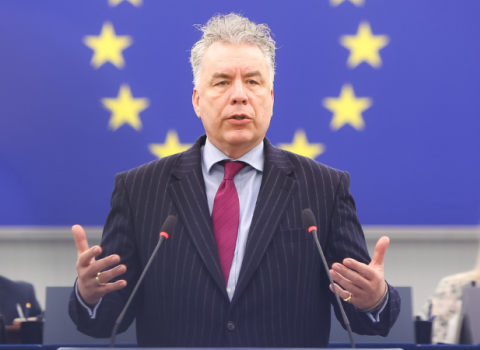EIT Climate is the first KIC to go public on a plan for maintaining operations once grants from its parent institute the EIT run out, as it gears its services towards the implementation of climate-neutral innovations

Kirsten Dunlop, CEO of EIT Climate-KIC
EIT Climate-KIC has revealed a plan to become the first financially sustainable EU-supported knowledge and innovation community (KIC) by the end of 2024, as it transitions towards a new way of fostering innovation.
In an interview with Science|Business, EIT Climate CEO Kirsten Dunlop said the KIC is moving towards a systems innovation as a service model, in which it will take on a key role in place-based projects, working with cities and regions to bring together, integrate and implement innovations that drive climate transition at a local level.
Financial sustainability was a goal when the EIT opened its doors in 2010 and set up the first three KICs. The hope was they would attract investment and become financially independent from the parent agency within a few years. Now, with the second tranche of seven-year grants running out, EIT Climate is the first to set out how it will wean itself off EIT grants.
It has taken longer than expected at the start, but the European Parliament’s rapporteur for the EIT, Maria da Graça Carvalho MEP, is happy to see one of the KICs is almost there. "The financially sustainability of the KICs is an important part of the EIT philosophy,” she says.
To ease the transition and scale up the service model commercially, the parent EU agency, the European Institute of Innovation and Technology (EIT), has awarded the climate KIC a final two-year, €20 million grant.
After that EIT Climate-KIC will fund its operations through various private, public and philanthropic sources, including funding from other parts of EU’s Horizon Europe research programme.
Value proposition
The recognition that it needed a new operating model came in 2017 when EIT Climate saw the challenge of reaching net zero was attracting more and more entrepreneurs into the field. That signalled it was time for a change to increase impact. “We need a value proposition that keeps moving with the programme,” says Dunlop.
The objective shared by the Climate KIC and this new generation of entrepreneurs is the same – reaching climate neutrality by 2050 – but the route there is long and twisting. Plus, with climate change accelerating, the gap between the goal and what is needed to bridge it is getting wider.
That dynamic requires a new approach, of starting with a clear objective in mind and working towards it. This is different from the approach innovation incubators such as EIT Climate have taken in the past, of supporting individual companies with relevant technology. “We observed from our own experience that a different way of engaging with innovation is needed if you’re engaging with a problem backwards,” says Dunlop.
This prompted EIT Climate to adopt a place-based approach, and switch to helping cities, regions and industry, or challenge winners, to plan their climate transitions. That involves bringing different innovations together to work at scale and maximise impact.
“We need to work out how to extend ourselves in how innovations are placed in the real economy and how they are combined,” says Dunlop. “If we cannot get innovation solutions to join up, then we’re really not owning the problem of climate change.”
As an exemplar for the new approach, EIT Climate is working with the authorities in Madrid, where it has put together a portfolio of technologies for rewilding, retrofitting homes, waste and water management, and street planning, among others.
Helping to establish frameworks in which these projects can attract finance and become investable is part of the mission. Madrid alone needs €10 billion a year to decarbonise, and while some national funding is available, it’s nowhere near enough. “The work that we do is about making markets and making market conditions, so that the thousands of start-ups and industry can generate alternatives, [and can] begin to construct new economic and business models,” says Dunlop.
Policymakers believe EIT Climate has the know-how to do the work. “It makes perfect sense that the Climate KIC will use its expertise to help national and local authorities and businesses [to] implement the solutions that will lead them to a successful green transition,” says Carvalho.
Diversified income
EIT Climate has built up a pool of public, philanthropic and private funders over the years. While as of now, EIT remains one of them, “the mix already had to change a long way back for us to be able to do this,” says Dunlop.
In 2021, the KIC’s budget was €39.1 million, of which €1.8 million came from membership fees, with funders other than the EIT contributing €6.7 million.
Although cutting the funding apron strings with EIT, EU funding will remain a part of the mix. A big part of this will be from the Horizon Europe Missions that aim to transition cities to climate neutrality and to help regions adapt to climate change, which the Climate KIC is helping deliver.
The long-term goal is to grow the share of philanthropic donations in the mix, allowing the KIC to create a pool funding that comes with no strings or particular goals attached, as is always the case with bureaucracy-heavy EU funds.
With the new mix of funding, change is coming, but Dunlop says the EIT model of innovation support will remain. EIT Climate will continue running training programmes, innovation projects and business incubators and accelerators to accelerate net-zero innovation.
Other EIT KICs are also working towards financial sustainability. EIT InnoEnergy is “well on the way to do so,” a spokesman confirmed.
“The funding we receive from the EIT - and as originally planned - has reduced substantially. Our source of income includes exits from portfolio companies, fee paying students, and private funding from 29 shareholders,” he told Science|Business.





 A unique international forum for public research organisations and companies to connect their external engagement with strategic interests around their R&D system.
A unique international forum for public research organisations and companies to connect their external engagement with strategic interests around their R&D system.